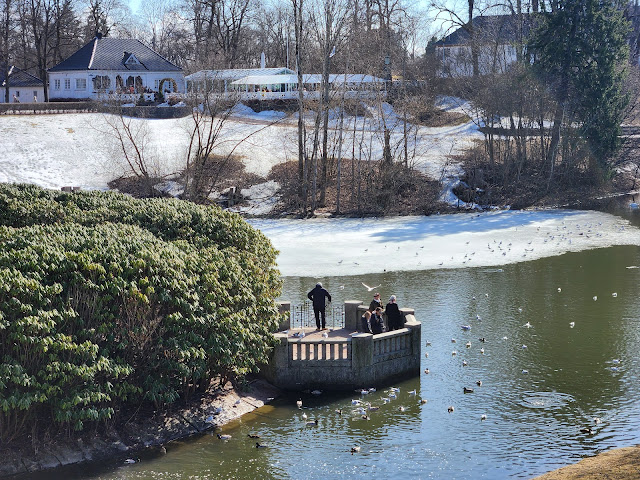 |
| The Vigeland Sculpture Park |
It consists of sculptures as well as larger structures such as bridges and fountains. The installation is not a separate park, but the name of the sculptures within the larger Frogner Park. Informally the Vigeland installation is sometimes called "Vigeland Park" or "Vigeland Sculpture Park"; the director of Oslo Museum Lars Roede said "Vigeland Park" "doesn't really exist" and is "the name of the tourists," as opposed to "Oslo natives' more down-to-earth name, Frogner Park."
A picture is worth a thousand words. Without much ado, let's go through the photos.
Photo Gallery
The below photos were taken on 04/07/2023, a cold sunny day.
 |
| The front gate of Frogner Park |
 |
| Two tree-lined trails leading to the Bridge |
The Bridge[2]
The Bridge's 58 bronze sculptures show a rich variety of children, women and men of different ages. Here you find the iconic little boy Sinnataggen (The Angry Boy). Shared themes for the sculptures on the Bridge are play, lust, energy and vitalism.
Vigeland modeled these sculptures in the period 1925-1933. They were some of the first sculptures that were mounted in Vigeland Park in the early 1940s.
 |
| The angry boy |
The Fountain[2]
Beyond the Bridge, the path continues through a rose garden to the Fountain, the earliest sculpture unit in the park.In the center of the basin six giants hold the large saucer-shaped vessel aloft and from it a curtain of water spills down around them. The men, representing different ages, may be interpreted as toiling with the burden of life.
Water, a universal symbol of fertility, is used within the fountain complex in a meaningful juxtaposition with the twenty tree groups on the surrounding parapet, the latter evidently symbolizing "the tree of life".
The tree groups represent a romantic expression of Man's relationship to nature. They also form the setting for life's evolving stages, stretching from childhood and adolescence through adulthood to old age and death.
The Monolith[2]
The Monolith stands at the highest point in Vigeland Park, and measures 17 meters above ground. The sculpture is carved out of one stone block, hence the name. The stone was originally shot out of the quarry in Iddefjord, Norway, and transported to the park during the late 1920s.The sculpture depicts 121 human figures clinging and floating together. There's women and men of different ages, and the top of the Monolith is crowned with children. The sculpture has been interpreted as a kind of vision of resurrection, and our longing and striving for spirituality.
Vigeland Sculpture Park (YouTube link)
References
- Frogner Park (Wikipedia)
- VIGELAND MUSEET

























No comments:
Post a Comment
Note: Only a member of this blog may post a comment.